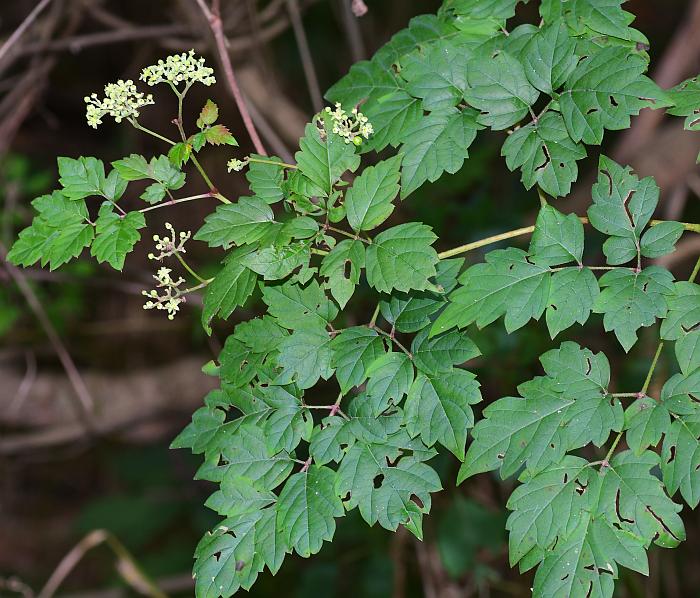Ampelopsis arborea (L.) Koehne
Pepper Vine

Native
CC = 7
CW = -3
MOC = 18
© SRTurner
Ampelopsis arborea (L.) KoehnePepper Vine | |
 |
Native CC = 7 CW = -3 MOC = 18 |
© SRTurner |
|
Family - Vitaceae Habit - Liana with tendrils, sometimes monoecious. Stems - To many meters long, woody below, climbing, with tendrils at scattered nodes opposite the leaves. Young growth reddish, with lenticels. Pith solid. Twigs glabrous or sparsely and inconspicuously hairy when young, becoming glabrous with age.
Leaves - Alternate, bipinnate, petiolate. Petioles and rachis glabrous to sparsely pilose, with a distinct square groove adaxially. Leaf blades 10-25 cm long, twice pinnately or pinnately then ternately compound, broadly triangular in outline, with 9-35 leaflets. Leaflets 2-6 cm long, mostly ovate, sessile or more commonly short-stalked, mostly truncate at the base, narrowed or tapered to a sharply pointed tip, the margins with a few broad coarse teeth, dark green, the upper surface shiny, glabrous or very sparsely hairy, the undersurface glabrous or sparsely hairy along the veins. Young leaves often deep reddish in color.
Inflorescence - Flat-topped or dome-shaped panicles, usually borne opposite the leaves, much shorter than the leaves, wider than long or slightly longer than wide, repeatedly dichotomously forked or with 3-5 umbellate branches, the flowers in small umbellate clusters at the tips of the ultimate branches. Peduncles glabrous or minutely pubescent.
Flowers - Petals 5, distinct, pale greenish, spreading, 2-3 mm long, acute, lanceolate-ovate, glabrous internally, with scarious, inflexed (involute) margins in the apical 1/2, puberulent externally. Stamens 5, erect, opposite the petals. Filaments greenish, glabrous, to 1.5 mm long. Anthers yellow-brown, 0.5 mm long. Ovary surrounded by a nectary to 2 mm in diameter, superior, glabrous, green. Style 0.5-0.7 mm broad, 0.2 mm long, scarious-green, acute, glabrous internally, puberulent externally. Calyx tube green, 0.8 mm long, puberulent.
Fruits - Globose berries 7-10 mm in diameter, changing from green to pink or bluish gray and eventually to dark purple or black, shiny at maturity and often with small warty dots. Seeds 1-3 per fruit, 3.5-4.5 mm long, asymmetrically obovoid to broadly obovoid, somewhat longitudinally angled along the inner side, reddish brown to yellowish brown. Flowering - June - August. Habitat - Bottomland forests, flood plain forests, swamps, streambanks, wooded roadsides. Origin - Native to the U.S. and Mexico. Other info. - This vining species occurs mostly in states to our south and east. In Missouri it is fairly uncommon, being found predominantly in counties bordering the Mississippi River and in a few counties of southwest Missouri. The plant is easy to identify because of its vining habit, divided leaves, and black fruits. The fruits are not palatable to humans but are a food source for wildlife. Photographs taken at Eufala National Wildlife Refuge, AL., 6-25-06 (DETenaglia); also at Lower Meramec County Park, St. Louis County, MO, 8-15-2022 (SRTurner). |